2. The nucleosome is the subunit of all chromatin
19.2 The nucleosome is the subunit of all chromatin |
| Key terms defined in this section |
| Micrococcal nuclease is an endonuclease that cleaves DNA; in chromatin, DNA is cleaved preferentially between nucleosomes. |
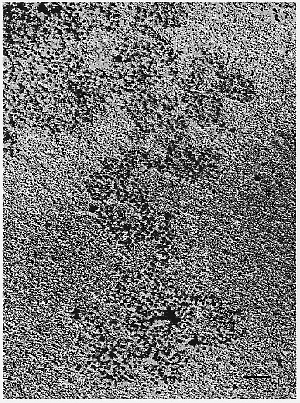 |
Figure 19.1 Chromatin spilling out of lysed nuclei consists of a compactly organized series of particles. The bar is 100 nm. Photograph kindly provided by Pierre Chambon. |
When interphase nuclei are suspended in a solution of low ionic strength, they swell and rupture to release fibers of chromatin. Figure 19.1 shows a lysed nucleus in which fibers are streaming out. In some regions, the fibers consist of tightly packed material, but in regions that have become stretched, they can be seen to consist of discrete particles. These are the nucleosomes. In especially extended regions, individual nucleosomes are connected by a fine thread, a free duplex of DNA. A continuous duplex thread of DNA runs through the series of particles.
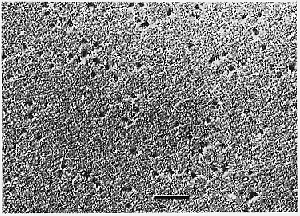 |
Figure 19.2 Individual nucleosomes are released by digestion of chromatin with micrococcal nuclease. The bar is 100 nm. Photograph kindly provided by Pierre Chambon. |
Individual nucleosomes can be obtained by treating chromatin with the endonuclease micrococcal nuclease. It cuts the DNA thread at the junction between nucleosomes. First, it releases groups of particles; finally, it releases single nucleosomes. Individual nucleosomes can be seen in Figure 19.2 as compact particles. They sediment at ~11S.
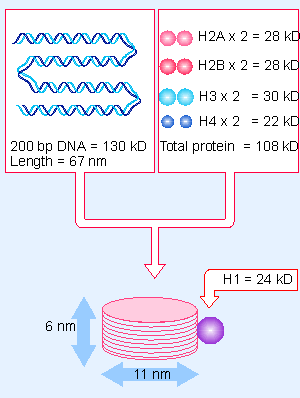 |
Figure 19.3 The nucleosome consists of approximately equal masses of DNA and histones (including H1). The predicted mass of the nucleosome is 262 kD. |
The nucleosome contains ~200 bp of DNA associated with a histone octamer that consists of two copies each of H2A, H2B, H3, and H4. These are known as the core histones. Their association is illustrated diagrammatically in Figure 19.3. This model explains the stoichiometry of the core histones in chromatin: H2A, H2B, H3, and H4 are present in equimolar amounts, with 2 molecules of each per ~200 bp of DNA (Kornberg, 1974; for review see Kornberg, 1977).
Histones H3 and H4 are among the most conserved proteins known. This suggests that their functions are identical in all eukaryotes. The types of H2A and H2B can be recognized in all eukaryotes, but show appreciable species-specific variation in sequence.
Histone H1 comprises a set of closely related proteins that show appreciable variation between tissues and between species (and are absent from yeast). The role of H1 is different from the core histones. It is present in half the amount of a core histone and can be extracted more readily from chromatin (typically with dilute salt [0.5 M] solution). All of the H1 can be removed without affecting the structure of the nucleosome, which suggests that its location is external to the particle.
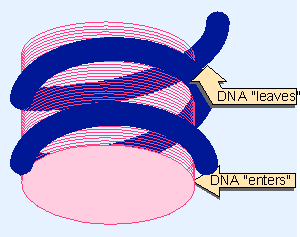 |
Figure 19.4 The nucleosome may be a cylinder with DNA organized into two turns around the surface. |
The shape of the nucleosome corresponds to a flat disk or cylinder, of diameter 11 nm and height 6 nm. The length of the DNA is roughly twice the ~34 nm circumference of the particle. The DNA follows a symmetrical path around the octamer. Figure 19.4 shows the DNA path diagrammatically as a helical coil that makes two turns around the cylindrical octamer. Note that the DNA "enters" and "leaves" the nucleosome at points close to one another. Histone H1 may be located in this region (see later) (Richmond et al., 1984).
 |
Figure 19.5 The two turns of DNA on the nucleosome lie close together. |
Considering this model in terms of a cross-section through the nucleosome, in Figure 19.5 we see that the two circumferences made by the DNA lie close to one another. The height of the cylinder is 6 nm, of which 4 nm is occupied by the two turns of DNA (each of diameter 2 nm).
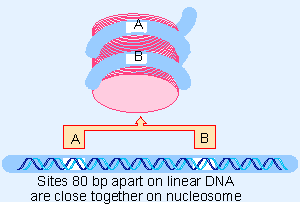 |
Figure 19.6 Sequences on the DNA that lie on different turns around the nucleosome may be close together. |
The pattern of the two turns has a possible functional consequence. Since one turn around the nucleosome takes ~80 bp of DNA, two points separated by 80 bp in the free double helix may actually be close on the nucleosome surface, as illustrated in Figure 19.6 (for review see McGhee and Felsenfeld, 1980).
| Reviews | |
| Kornberg, R. D. (1977). Structure of chromatin. Ann. Rev. Biochem 46, 931-954. | |
| McGhee, J., D. and Felsenfeld, G. (1980). Nucleosome structure. Ann. Rev. Biochem 49, 1115-1156. | |
| Research | |
| Kornberg, R. D. (1974). Chromatin structure: a repeating unit of histones and DNA. Science 184, 868-871. | |
| Richmond, T. J., Finch, J. T., Rushton, B., Rhodes, D., and Klug, A. (1984). Structure of the nucleosome core particle at 7 Å resolution. Nature 311, 532-537. | |